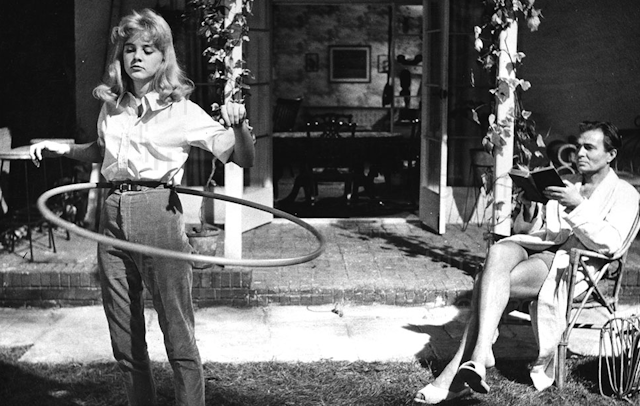When Vladimir Nabokov was approached by Stanley Kubrick in 1959 about making a movie of his masterpiece, Lolita, Nabokov at first refused the temptation to write the screenplay. But then, having “experienced a small nocturnal illumination, of diabolical origin”, he fell into a cinematic dream and composed his now famously impossible 400-page screenplay.
Kubrick’s producer, James B Harris, was typically dismissive: “You couldn’t make it. You couldn’t lift it.” His words reflected the standard film industry condescension towards writers. But what neither Harris nor Kubrick realised was that Nabokov was streets ahead of them.
Almost 30 years earlier, when Kubrick was just four years old and cinema was in its infancy, Nabokov wrote a short novel in Russian called Kamera Obskura (soon translated into English as Laughter in the Dark). It told the story of a man, Albinus, slightly drunk with the idea of cinema, who falls for an aspiring actress and whose life ends in disaster. The novel is a movie – not literally – but literarily. Here are a few of the words of Albinus’ disastrous ending:
Stage directions for last silent scene: door – wide open. Table – thrust away from it. Carpet – bulging up at table foot in a frozen wave. Chair – lying close by dead body of man in purplish brown suit and felt slippers. Automatic pistol not visible. It is under him. Cabinet where the miniatures had been – empty. On the other (small) table, on which ages ago a porcelain ballet-dancer stood (later transferred to another room) lies a woman’s glove, black outside, white inside. By the striped sofa stands a smart suitcase, with a coloured label still adhering to it: ‘Rouginard, Hotel Britannia’.
This is the most explicitly scripted piece of writing in the novel which provides a distillation of the state of cinema at the time, ending with that cinematic cliché: the post-murder room in disarray.

A few of the phrases in the extract remain purely literary – in a screenplay, one doesn’t mention anything that can’t be seen, as Nabokov mentions the invisible gun and the porcelain ballet-dancer. Others are pure screenplay. The phrase “stage directions for last silent scene” is such a postmodern touch that it is amazing to find it in a work from the early 1930s.
Cinema, like butterflies (Nabokov was a respected lepidopterist), and all the things Nabokov worked over obsessively in his novels, had clearly taken hold of him at a young age. The opening paragraph of his 1966 memoir, Speak, Memory, refers to the disturbing childhood experience of seeing home movies taken weeks before he was born – before he existed – and feeling that his mother’s wave from an upstairs window was some mysterious farewell. This seems to encapsulate Nabokov’s ambivalent feeling for cinema and its centrality to his art. The power of the visible surface, the very many possible interpretations of any filmed action.
But Laughter in the Dark is more than just inspired by the movies. It is, in its conception, a fusion of novel and film. Like Joseph Conrad before him, Nabokov dreamt of making the reader “see” (see the movie in the mind’s eye, and feel the power of the images). Proof that he was self-consciously writing a movie occurs when Albinus, having an hour to kill, goes to the cinema.
At the movie theatre, there is a publicity poster which “portrayed a man looking up at a window framing a child in a nightshirt”. This photographically composed image, with its double framing of the child, is evidence of Nabokov’s acute cinematic sense. The framed child reappears later on, in the form of Albinus’ own daughter in a window, but by this time the reader has forgotten the poster. The “viewer” on the other hand, would not have.
Fantastic possibilities
And it may only have been on second writing that these images made their way into the story. Laughter in the Dark is Nabokov’s own translation from the Russian original, which means the method too was like that of the screenwriter, who writes many drafts, maybe using index cards as Nabokov did. So Laughter in the Dark became a dramatised analysis of the difference between a novel and a movie.
It is also a demonstration of the lessons a novelist can learn from the art of cinema and of the fantastic possibilities of cinema’s visual language. Not until Alfred Hitchcock’s greatest films did cinema achieve anything like the fluidity or visual acrobatics of Laughter in the Dark. Here, in Nabokov’s wonderful language, we find not just the cinematic staging of “scenes”, but framing, montage, snappy dialogue, the jump cut, the wide-angle shot, the aerial shot, the extreme close-up, even dramatic lighting effects.
Yet, from the 1950s onwards, under the influence of the Auteur Theory, the movie industry contrived to keep novelists as far away from any power in the industry as they possibly could and to cast screenwriters (and the screenplay) as mere cogs in the production process, even banning writers from the set.
Which brings me back to the “impossible” screenplay for Lolita. The only thing impossible about it is its length. Otherwise, it is a screenplay that only a cinematic master could have written. Understandably, Kubrick had to boil its 400 pages down. But with today’s digital technology making film so much cheaper to produce and a wider variety of viewing platforms available, Nabokov’s dream could be realised, word for word, image for image.
Of the two existing adaptations, Nabokov himself lamented the flaws in the Kubrick version. He was not alive to react to Adrien Lyne’s interesting but overly sympathetic 1997 version.
His own screenplay could become the definitive screen Lolita. It could serve to protect the novel’s reputation, correct the errors of the two existing adaptations and prove once and for all that the screenplay is a legitimate literary form, as potentially complete in its vision as the novel.

